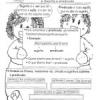
We selected in this post some Rules and Combinations, ready to print and apply in early grade classrooms.
The school environment is the place for the child to experience for the first time what it is like to live in society, without having parents or guardians as the figures who attend to and resolve their wishes and difficulties. It is during this period that the little ones learn to deal with differences and respect them. But, beyond that, it is also the time when they realize that there are other strategies to satisfy their needs, such as aggression, cursing, biting and crying. Dealing with this type of behavior may seem difficult, but it is through such signs that it is possible to establish good coexistence and respect for the rules.
No matter the age, rules and limits are part of society and from an early age we must learn to live with them.
Knowing that your right ends where the other's right begins, learning to deal with differences and resolve your conflicts is a constant in life, regardless of the stage of it.
See too:
Index
Making arrangements doesn't just mean capturing the students' opinions and building a beautiful poster with the group's responsibilities. It also means a change in attitude on the part of the educator. The teacher needs to abandon the old authoritarian methods and propose to build an affective relationship with his class. He needs to be willing to listen, to respect each child, to earn the confidence of the class. It needs to set fair limits that help the child to develop morally, rather than just causing humiliation and anger. Acting like this, the teacher usually takes more time to gain the respect of the class, however, when this achievement occurs, it is permanent, as the teacher reaches an authority that is not based only on fear, but on a true relationship of trust and admiration. by the master. When we educate children to behave well out of fear of punishment, we run the risk of train people who are able to obey when they are watched, but who act unethically when “no one is looking". The combinations help to create an authentic citizenship and not just a game of social hypocrisy where what counts is the appearance of kindness.
The classroom is a reflection of the baggage that the student brings from home. If some don't give work, they know how to behave and have discipline, others believe they are in their own living room, where they do what they want. Therefore, it is important to establish rules from day one, to avoid indiscipline.
The environment of an early childhood education classroom should be pleasant and pleasant, in a way that promotes stimulating relationships for the child's development with the teacher, with studies, with other children and with rules.
The way of conducting the relationship between students, interacting with them and proposing activities interferes with learning.
Be sure to check: What to do on the first day of class?
See too:
At Rules and Combinations below are illustrated with characters from cartoons and children's movies: Tom and Jerry, Minnions, Mickey, Lion King, Timon and Pumbaa, among others.

Subscribe to our email list and receive interesting information and updates in your email inbox
Thanks for signing up.


